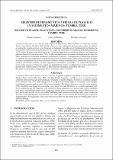Por favor, use este identificador para citar o enlazar este ítem:
https://hdl.handle.net/20.500.12958/3583Registro completo de metadatos
| Campo DC | Valor | Lengua/Idioma |
|---|---|---|
| dc.contributor.author | Cisneros Linares, Paola | - |
| dc.contributor.author | Montero, Percy | - |
| dc.contributor.author | Guevara, Mervin | - |
| dc.contributor.editor | Instituto del Mar del Perú | - |
| dc.date | set. 2021 | - |
| dc.date.accessioned | 2021-10-14T17:20:16Z | - |
| dc.date.available | 2021-10-14T17:20:16Z | - |
| dc.date.issued | 2021-09 | - |
| dc.identifier.citation | Cisneros P, Montero P, Guevara M. 2021. Registro de fragmentos y fibras de plástico en sedimentos marinos, Tumbes, Perú. Inf Inst Mar Perú. 48(3): 478-483 | es_ES |
| dc.identifier.issn | 0378-7702 | - |
| dc.identifier.uri | https://hdl.handle.net/20.500.12958/3583 | - |
| dc.description.abstract | Se da a conocer el registro de fragmentos y fibras de plástico en sedimento marino, entre el sector Huacura y Quebrada Fernández en el Departamento de Tumbes. Se recolectaron 76 muestras de sedimento con una draga Van Veen (0,05 m2), hasta una profundidad máxima de 70 metros. Se registraron 30 muestras que contenían fragmentos y/o fibras de plástico. Los fragmentos plásticos fueron los mas frecuentes (73%), las fibras se encontraron en zonas más alejadas de la costa. Las fibras estuvieron mayormente asociadas a sedimentos arcillosos y los fragmentos a sedimentos arenosos y arcillosos. En una estación con sustrato rocoso se halló la presencia de ambos residuos junto a la fauna bentónica acompañante de un banco de choro (Modeolus pacax) y no se descarta la posibilidad de que dichos residuos interactúen también con otros organismos bentónicos comerciales y no comerciales presentes en las zonas rocosas en Punta Sal. Según sus características físicas, los fragmentos podrían provenir de pintura para embarcaciones y las fibras de artes de pesca empleadas en la pesca artesanal. | es_ES |
| dc.description.abstract | ABSTRACT: Plastic fragments and fibers were recored in marine sediment, between Huacura and Quebrada Fernández in Tumbes Region. Seventy-six sediment samples were collected with a Van Veen dredge (0.05 m2 ), up to a maximum depth of 70 meters. Thirty samples containing fragments and/or plastic fibers were recorded. The plastic fragments were the most frequent (73%), the fibers were found in areas further away from the coast. The fibers were mostly associated with clayey sediments and the fragments with sandy and clayey sediments. In a station with a rocky substrate, both plastic type residues were found, along with benthic fauna accompanying a mussel (Modeolus pacax) bed, and it does not rule out the possibility that these plastic residues also interact with other commercial and non-commercial benthic organisms present in the rocky areas in Punta Sal. According to its physical characteristics, the fragments could come from boat paint and the fibers from the fishing gear used in artisanal fishing. | - |
| dc.language.iso | spa | es_ES |
| dc.publisher | Instituto del Mar del Perú | es_ES |
| dc.relation.ispartofseries | Informe IMARPE;48(3), 2021 | - |
| dc.rights | info:eu-repo/semantics/openAccess | es_ES |
| dc.rights.uri | https://creativecommons.org/licenses/by/4.0/ | es_ES |
| dc.source | Instituto del Mar del Perú - IMARPE | es_ES |
| dc.source.uri | Repositorio Digital IMARPE | es_ES |
| dc.subject | Sedimentos marinos | es_ES |
| dc.subject | Residuos marinos | es_ES |
| dc.subject | Plásticos | es_ES |
| dc.subject | Tumbes | es_ES |
| dc.title | Registro de fragmentos y fibras de plástico en sedimentos marinos, Tumbes, Perú | es_ES |
| dc.title.alternative | Record of plastic fragments and fibers in marine sediments, Tumbes, Peru | es_ES |
| dc.type | info:eu-repo/semantics/article | es_ES |
| dc.publisher.country | Perú - Callao | es_ES |
| dc.subject.ocde | http://purl.org/pe-repo/ocde/ford#1.05.05 | es_ES |
| Aparece en las colecciones: | Informe vol. 48(3) 2021 | |
Ficheros en este ítem:
| Fichero | Descripción | Tamaño | Formato | |
|---|---|---|---|---|
| Informe 48-3 articulo13.pdf | 4,89 MB | Adobe PDF |  Visualizar/Abrir |
Este ítem está sujeto a una licencia Creative Commons Licencia Creative Commons

